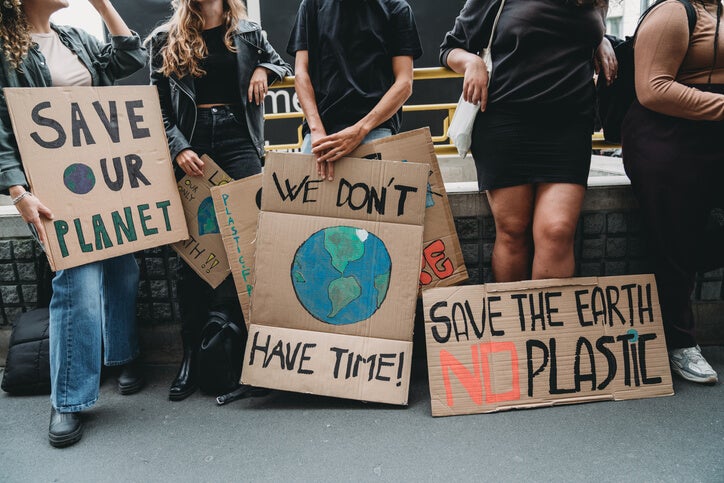How is climate change going to affect how I run my small business?

Running a business in an ever-changing world can be tough, especially when you’re just trying to keep ‘business as usual’. However, what are we supposed to do when the Earth decides that business won’t run as usual?
Debated for its existence and impact, climate change has become a huge factor in the way businesses work and should work in the future. With this handy Bionic guide, we’ll take a look at how climate change can affect your small business and how to tackle it head-on.
Five-point summary
- Climate change, largely driven by human activity, is causing harmful shifts in weather and temperature, leading to urgent risks such as more frequent extreme weather events, increased physical and transitional risks, and a rise in climate-related regulation and litigation.
- Businesses face significant physical, liability, and transitional risks due to climate change, including direct damage from events like floods, supply chain disruptions, tougher working conditions, and rising insurance and operational costs.
- Consumer preferences are shifting: awareness of sustainability is rising, especially among younger generations, with greater demand for eco-friendly products and transparency, but affordability remains a key barrier for many.
- The UK has historical responsibility for global emissions and strong legal commitments to lower greenhouse gases, with national legislation aiming for net zero by 2050 and oversight from the Climate Change Committee.
- Businesses can help tackle climate change by reducing energy use, choosing sustainable suppliers, and minimising travel, all of which can reduce operating costs, improve reputation, and prepare companies for future regulatory challenges.
What is climate change?
Formally referred to as global warming, climate change refers to the long-term shifts that we’re currently experiencing in the Earth's temperatures and weather patterns.
Although some argue that these shifts are natural, human activity has been one of the primary drivers of climate change. Activities such as burning fossil fuels (oil, coal and gas), mismanagement of waste and the unsustainable harvesting of natural resources have caused a climate crisis through the effect of greenhouse gases.
Ongoing analysis from leading NASA scientists states that the Earth's average global temperature has increased by at least 1.1°C since 1880.
Why is climate action so urgent?
In just the past few decades, the planet has seen:
- Rising temperatures due to adverse and worsened weather events
- Wildfire seasons are lasting months longer than usual
- Coral reefs have been bleached of their bright colours
- Chunks of ice in the Antarctic have broken apart
When the world warms up, even by just 0.5°C, evaporation increases, which leads to more water in the atmosphere. When conditions change to the extent that humans, animals and the planet aren’t accustomed to them, this puts our health, water supply and agriculture at risk.
What are the risks of climate change?
Three main risks of climate change will affect everyone, not just businesses.
1. Physical risks
The physical risks of climate change are any immediate threats that come from the physical environment. Events such as wildfires, flooding, hurricanes and droughts are all symptoms of climate change that can and will cause an impact on a global level.
The skiing industry, for example, is already seeing an immediate threat from climate change as rising temperatures reduce snowfall, meaning resorts have shorter seasons.
2. Liability risks
Climate litigation is increasing worldwide, and liability risks arise when companies fail to adapt to, mitigate, disclose or comply with the ever-changing legal and regulatory requirements. There’s also an even greater focus being placed on this from regulators and investors who want to ensure that the businesses that they’re supporting are complying with this landscape.
3. Transitional risks
Transitional risks are any potential costs to businesses that could come from the introduction of laws, policies and other regulations that address climate change.
The energy and mining sectors are the biggest industries that are most likely to be impacted by transitional risks. With the global push for greener energy sources, governments are facing increasing pressure to shift toward a reliance on renewable energy, meaning the energy sector has to find a solution and implement it.
Precious metals could be at financial risk from policies that introduce carbon prices. The negative effects of mining on the environment and the climate are increasingly becoming a reputational issue for mining companies and investors.
Why is it important for my business to care about the risks of climate change?
As climate change transforms the way that consumers, employees and shareholders interact with businesses, it’s become vital to incorporate climate change into their strategic plans. A warming planet creates a wide range of risks for businesses, from labour challenges to rising costs of supply chains and added disruption. Extreme weather conditions, such as floods and fires, have a direct impact on 70% of all economic sectors worldwide.
By taking action now, businesses can lower the risks that come from climate change and even take advantage of opportunities that a green future makes — failure to do so will undermine the sustainability of the business.
How can climate change affect my business?
Climate change isn’t just an environmental problem — it’s inextricably linked to nearly everything that we do as a society, and we’re already seeing these consequential shifts within businesses. Some of the most prominent ways that climate change will affect businesses include:
Increased risk due to extreme weather conditions
The risk of extreme weather events like storms, floods, heatwaves and droughts has caused major disruption to business operations, and it’s only going to get worse as temperatures increase.
From this disruption comes extreme financial and physical damage, meaning businesses are having to fork out of their own pockets to replace goods and fix issues. Severe weather is a primary reason that climate change increases risks for businesses as well, and because of this risk, insurance prices are on the rise, meaning businesses will have to pay more.
Harsher working conditions
As weather patterns change and we see temperatures rise, certain sectors may see harsher working conditions. Jobs that require physical labour — particularly outdoors — such as airport ramp agents or outdoor activity instructors, will become more challenging.
With these challenges also comes a rise in health and safety risks. Learn more about protecting yourself and your employees in the workplace with our health and safety guide.
Change in cost and resource availability
Extreme weather events have the potential to disrupt supply chains, meaning getting the stock of materials or resources to businesses has become even more of a challenge. For eateries or businesses that sell food and drink, severe droughts and weather pattern changes have caused shortages in crops, meaning food scarcity has increased.
Rising transportation and electricity costs may also increase the cost of moving goods, charging this back to businesses and causing price increases for the customer.
Increased public pressure
As the public grows more conscious and accepting of the facts of climate change, it becomes less acceptable for businesses that fail to reduce their impact on the environment.
Consumers are actively searching for businesses that produce sustainable products or have a smaller environmental impact compared to other companies or products on the same level.
There’s also increased public pressure on companies to take steps to become more socially responsible in their operations, be more environmentally friendly and donate to positive environmental charities. Major brands like IKEA, Apple, LEGO and Starbucks have all committed to producing 100% renewable energy.
But as public pressure increases, some businesses hop on the bandwagon and make claims about their green future, without ever committing to it.
How can extreme weather events affect your business operations?
Extreme weather events can have a significant impact on UK business operations, particularly for small and premises-based businesses. Here's how:
1. Physical damage to property
Flooding, high winds, or storms can damage business premises, equipment, stock, or signage, leading to costly repairs and downtime. Check out this Bionic guide for more information on how to protect your business from storms and bad weather.
2. Disrupted supply chains
Extreme weather can delay or stop deliveries, especially if transport networks are affected by snow, flooding, or fallen trees. If you have international suppliers, adverse weather across the globe can affect your business in the UK.
3. Power outages
Storms or heatwaves can lead to power cuts, disrupting everything from lighting and heating to payment systems and machinery.
4. Staff shortages
Adverse weather can make commuting unsafe or impossible, leading to reduced staffing or even temporary closures.
5. Customer access issues
Severe weather can keep customers away, particularly if your business relies on footfall or in-person appointments.
6. Increased energy use and costs
When the weather's bad, we tend to use more energy for lighting and heating. And when we use more energy, this instantly increases the cost of our energy bills. But increased demand during cold snaps and heatwaves can push up heating or cooling costs, especially if you're on an out-of-contract or variable energy tariff. That's why it makes sense to switch to a fixed-rate business energy contract and protect against price volatility.
7. Insurance and recovery delays
High volumes of weather-related claims can slow down the insurance process, delaying your recovery or payout after an incident.
How is climate change influencing consumer preferences?
There's evidence to suggest that climate change is having a significant influence on consumer preferences in the UK. As you might expect, much of it comes down to the affordability of goods and services, but some is also generational.
Here are some of the key trends in consumer preferences that may, in part at least, be influenced by climate change:
- Rising awareness of sustainability - UK consumers are increasingly aware of sustainability and environmental issues when making purchasing decisions. Around two-thirds (66%) now rate environmental impact as important when buying products, and 57% say that living sustainably has become more important to them over the past year.
- Price sensitivity is key - Although climate concerns are growing, price remains the most important factor for most UK consumers. 93% rate price as “very/somewhat important” compared to 66% for environmental impact. Cost-of-living pressures mean that half of Britons would like to do more for the environment but feel they can't afford to, and 64% of consumers only opt for a more sustainable product if it costs the same as the conventional option.
- Appeal to younger generations - Concerns about climate change are especially prominent among younger consumers, as 56% of those aged 16 to 34 say environmental impact has become a bigger factor in their purchasing over the past year (up 13% from 2024)https://www.ipsos.com/en-uk/price-trumps-planet-britons-want-sustainable-products-budget. Nearly 60% of 18 to 29-year-olds choose different brands for sustainability reasons, especially regarding packaging.
- Certain products are affected more than others - Sustainability considerations are strongest in categories like groceries, household, and beauty products. Packaging is a primary concern - 65% say ease of recyclability is decisive, and 89% would choose fibre or cardboard over plastic if given the option. More than a third (37%) have reduced their consumption of plastic-packaged goods.
- Second-hand is growing - Consumers are increasingly shopping for second-hand items and repairing rather than replacing. They're also seeking products that can be reused, recycled, or are designed for longevity. Cutting food waste, buying locally, and limiting single-use plastics have become common sustainable behaviours.
How much is the UK responsible for climate change?
It’s tempting to think that a country the size of the UK can't possibly play as big a role in climate change as countries the size of America or China. But that isn’t always the case.
The UK is actually one of the biggest contributors to global warming over time. This is due to our long history of generating greenhouse gases, which dates back to the beginning of the Industrial Revolution, creating emissions in both the US and the UK in the eighteenth and nineteenth centuries.
A study conducted by Oxfam found that European and North American countries currently consume more and have higher emissions per person, on average, compared to people in China or India, which have larger populations.
What are the UK government's climate change commitments?
Politicians in the UK have known about climate change and its consequences for years, but some are still refusing to acknowledge this. However, the UK government has put certain measures in place to tackle climate change.
The Climate Change Act 2008
The UK was the first country in the world to create a legally binding commitment to cut greenhouse gas emissions. Known as ‘The Climate Change Act 2008’, the government committed, by law, to reduce greenhouse gas emissions by at least 80% of 1990 levels by 2050. In 2019, this target was amended to achieve net zero emissions (100%) by the same time frame.
The Committee on Climate Change
The CCC — The Committee on Climate Change — advises the government on emissions targets and reports to Parliament on the progress that has been made in reducing greenhouse gas emissions.
The Climate Change Committee has an important role in monitoring the actions taken by the government and undertakes an annual assessment of whether the UK is on course to meet its carbon budgets.
What can businesses do to help climate change?
There are simple ways that businesses can help in the fight against climate change — even small differences can make a big impact!
1. Reduce energy consumption
Focusing on energy reduction can result in big wins for businesses, both in terms of cost savings and sustainability.
If you’re looking into how to make your business energy efficient, most companies look toward simple solutions like updating to LED lights and properly optimising heating and cooling systems, as well as installing energy-efficient products.
If you're unsure how much energy your business should be using, our guide to average business energy usage should have the answers.
2. Choose sustainable suppliers
As companies work to make their business greener, they must look toward their supplier line to see the action that they’re taking. You can’t claim to be working toward a sustainable future but still get supplies that are made or become unsustainable somewhere along the line.
Ensuring that any suppliers you work with are sustainable means that sustainability remains a priority throughout the entire supply chain.
3. Minimise business travel
Business travel is one of the biggest contributors to a business's high rate of emissions.
Normalised by the Covid-19 pandemic, shared online drives and online video calls have played a huge part in helping to reduce business travel, making it easier for businesses to reach staff, customers and suppliers alike.
If travel is required and the destination is close, public transport like buses, trains and trams can help in reducing carbon emissions.
Get your business set with Bionic
At the end of the day, we all want to see our businesses flourish the right way whilst protecting the Earth as best as we can. From understanding climate change to the simple steps businesses can take, our guide can help.
Get in touch today with the Bionic team to discuss your needs or get more information on business finance.








